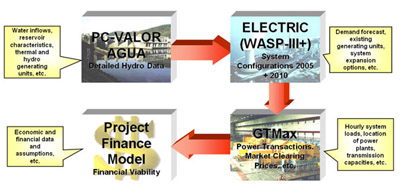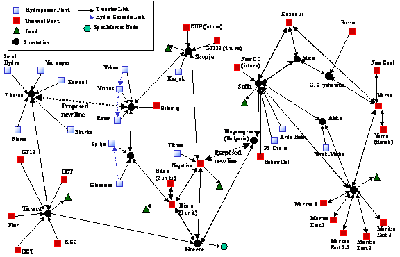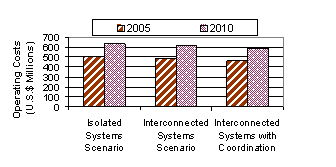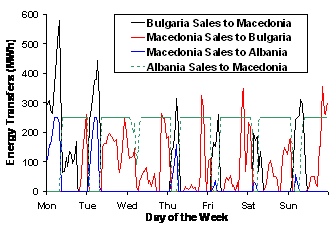| Center for Energy, Environmental, and Economic Systems Analysis (CEEESA) |  |
Research Areas:
Energy, Environment, and
Economics
National and Homeland
Security
Infrastructure Assurance
Emergency Preparedness
Social Dynamics
Policy Analysis
Core Capabilities:
Systems Analysis
Modeling, Simulation, and
Visualization
Complex Adaptive Systems
Decision Support and Risk
Management
Information Sciences
Power Market Analysis and Potential Revenues of Two New Transmission Lines in the Balkans Methodology: Experts from the Center for Energy, Environmental, and Economic Systems Analysis (CEEESA) developed an integrated modeling framework for the power market analysis that consisted of several computer models. The framework comprised the ELECTRIC/WASP module of Energy and Power Evaluation Program (ENPEP), the PC-VALORAGUA (Value of Water) model, the Generation and Transmission Maximization (GTMax) model, and the Project Finance Model for the financial analysis of the simulation results (see figure below). The analysis focused on the power market situation in two key years: 2005 and 2010. Integrated Modeling Framework
The first scenario analyzed the situation in which the three power systems (i.e., Albania, Bulgaria, and Macedonia) operate independently and do not trade, sell, or exchange energy or capacity with each other or with the Greek power system. The results of this scenario provided electricity generation costs in each of the utility systems. The second scenario with the interconnection lines allowed for power exchanges between the three utility systems. In this scenario, the GTMax model was used to determine the potential for power transactions, optimize the exchanges between the utilities, and to determine market-clearing prices in each node of the network, including the market-clearing prices for possible exports to Greece. The results of the GTMax model were further transferred to the Project Finance Model to determine the economic and financial viability of the proposed new interconnection lines. Results of Expansion Studies: The expansion analysis for the electric power system of Macedonia was carried out using the WASP/VALORAGUA methodology, while the expansion analyses for the power systems of Bulgaria and Albania were carried out with the WASP model. The analyses of expansion options for these three electric power systems were carried out for two main scenarios, i.e., expansion of isolated utility systems, and expansion of interconnected systems. Expansion of Isolated Utility Systems: In the analysis of this scenario, the generating system expansion analysis was carried out separately for each of the three isolated systems. Each power system was considered to be completely independent and the expansion analysis was carried out with the objective of maintaining self-sufficiency in supplying its own electrical demand over the study period. The potential expansion options and candidate generating technologies were chosen in such a way to take into account both local energy resources as well as potential imports of fuel in the future. The sizes of candidate generating units were selected in accordance with the size of each power system. However, although expansion analyses for the three power systems were carried out independently, some of the key assumptions were standardized across all three expansion analyses. For example, the desired reliability of system operation in the future was standardized by specifying identical input parameters for the reserve margins, energy-not-served (ENS) cost, and loss-of-load probability (LOLP). Also, some key economic parameters and criteria (e.g., present worth date, discount rates, depreciation methods, fuel price projections, etc.) were held constant in all three expansion analyses. The expansion analysis for the isolated systems was carried out with three main objectives:
The system configurations in 2005 and 2010 obtained from the WASP/VALORAGUA analysis were then transferred to the GTMax model to determine potential opportunities for power transactions between the three utilities. Expansion of Interconnected Systems: The expansion of interconnected systems was carried out for two main scenarios. The analysis of the first scenario was carried out with the assumption that all three utilities will follow their respective expansion programs as obtained in the analysis of the isolated systems. Because in the analysis of this scenario the WASP model was not used to perform an optimization of future capacity additions, this type of analysis is called a fixed expansion program. However, in the area of system operation, all three utilities were assumed to operate as a single tightly interconnected power pool. The analysis was conducted without transmission constraints (no congestion) and assuming a joint dispatch of generating units in all three systems to satisfy the combined system load. As in the case of expansion analyses that were carried out for the isolated systems, the dispatch of generating units was based on the economic loading order, adjusted for the spinning reserve requirements. The system operation results that were obtained in this fixed expansion scenario for years 2005 and 2010 were then compared to the respective operation results obtained from the expansion plans of the isolated systems. The cost difference between the operating costs in these two scenarios (fuel, fixed and variable O&M costs) provided an indication of maximum interconnection benefits in these two years. The present value of the total cost savings over the study period 2000-2020 amounted to about $891 million. This value was obtained by comparing the total cost over the study period for the fixed expansion scenario with the sum of respective total costs for the least-cost expansion programs obtained for the three isolated systems. It should be noted that not all of these costs savings can be directly attributed to the new interconnection lines Dubrovo-Radomir and Vrutok-Burrel. The portion of cost savings that can be attributed to these two proposed transmission links is calculated with the GTMax model. The analysis of the second scenario for the expansion of interconnected systems was carried out assuming that the three utilities would not only operate as a power pool, but also conduct a joint expansion planning and optimize their future development on a regional basis. In this case, the least-cost expansion analysis was optimized for the combined system without regard to the individual expansion plans that were obtained for the isolated utility systems. Naturally, the expansion options that were considered in this case were based on the candidate technologies that were also examined in the analysis of isolated systems, and their geographical locations were taken into account. This second scenario, which assumed an optimized expansion of the completely interconnected regional system, allowed for the calculation of additional savings coming from the lower investment costs into the new generating capacity over the study period. These cost savings are in addition to the savings from the joint operation that were examined in the analysis of the first scenario, in which all three utilities operate as a single power pool, but maintain their independent expansion plans. Because of the non-coincidence of peak loads, lower spinning reserve requirements, etc., the combined system needs less new capacity over the study period than the isolated development of three independent systems. Also, because of the bigger size of the combined system, the optimized expansion program may contain candidate units of larger size that are generally more efficient and less expensive in terms of specific investment costs per kilowatt of installed capacity. The results that were obtained in this second scenario for the expansion of interconnected systems were then compared to the respective results obtained for the expansion of isolated systems. WASP/VALORAGUA results for the optimized expansion showed a reduction of 1,086 MW in new capacity additions over the period until 2020. The present value of the total cost savings over the period 2000-2020 amounted to about $1,372 million. A comparison of total system investment and operating costs over the period 2000-2020 obtained for the expansion of isolated systems, fixed expansion of interconnected systems, and for the optimized expansion of interconnected systems is illustrated in the figure below. All costs are expressed in constant U.S. dollars as of the beginning of 1999. Comparison of Total Expansion Costs over the Period 2000-2020 for Three Scenarios Results of Power Market Analysis: The system configurations of generating units that will be likely to operate in Albania, Bulgaria, and Macedonia in 2005 and 2010, as determined by the WASP/VALORAGUA expansion studies, were then passed on to the GTMax model to simulate their hourly operations and market potential for power transactions. GTMax estimates the hourly dispatch of thermal and hydropower resources and determines the set of units that are committed to be operational during simulated weeks. The model also estimates hourly market prices of electricity on a regional basis. For this analysis, the model was run on hourly basis for four weekly periods that are representative of the seasons. These include the third weeks of the following months: January (winter), April (spring), July (summer), and October (autumn). System operations were simulated for two snapshot years, 2005 and 2010, and under three hydrological conditions. GTMax was used to estimate the operations of three Balkan utilities under three scenarios. Under the first scenario, Isolated Systems, it is assumed that the three power systems operate independently and that the countries neither exchange energy nor engage in the buying and selling of electricity via interconnections with other systems. Therefore, each system is responsible for satisfying its own electricity demand by means of its own generation resources while maintaining an adequate level of spinning reserves to ensure system reliability. Under the second scenario, Interconnected Systems, a transmission line connects the Bulgarian and Macedonian systems with an operational transfer capability of up to 1,000 MW. A second line connects Albania and Macedonia with a transfer capability of 250 MW. The GTMax model computes the amount of energy that is purchased and sold via these transmission lines on an hourly basis under the assumption that all transactions are based on short-term non-firm agreements. These agreements are energy-only transactions with no firm capacity component. Unit commitments under this scenario are identical to the Isolated Systems Scenario under the assumption that each individual system would be self-sufficient in the event that a non-firm transaction with another country is interrupted. The third scenario, Coordinated Systems, is identical to the second scenario except that there is short-term (i.e., a weekly) coordinated planning among operators in the three systems. This entails determining unit commitments based on a single integrated system. Additional benefits can be gained by placing units that are expensive to operate on cold standby and allowing less expensive units to operate at higher capacity factors. In addition, by taking advantage of load diversity, more units can be placed on cold standby than under the first and second scenarios. Under the Coordinated Systems scenario it is assumed that there is a fairly high level of interdependence among the systems and that energy transactions are very reliable. The topology of the network that is configured in GTMax for the three Balkan countries is shown in the next figure. GTMax computes the market-clearing price of electricity at various geographical locations within each of the three power systems and at power system interconnections. The market-clearing price is assumed to be the marginal cost of delivering energy to a specific location. All energy transferred through an interconnection line is charged at the same market-clearing price. Total purchase expenses and sales revenues are set equal to the market-clearing price times the amount of energy sold. GTMax Representation of the Interconnected Systems Albania-Macedonia-Bulgaria The figure below shows GTMax results for the net operating costs in 2005 and 2010 for the weighted average hydrological condition. In principle, the costs under all scenarios increase as the hydrological conditions become drier. This cost increase is notably higher for Albania since it relies on hydropower plants to satisfy most of its electricity demands. On the other hand, net operating costs for Albania in 2005 under wet hydrological conditions are negative when the systems are interconnected. This occurs since generation costs are minimal and the country has large amounts of excess hydropower to sell. However, net costs in Albania under the Coordinated Systems Scenario during wet periods are positive since cold standbys are optimized over the three combined systems and most thermal units in the country do not operate. Energy purchase levels increase and the price becomes expensive as the Albania-Macedonia line is at maximum transfer capability most of the time. Comparison of Net Operating Costs in 2005 and 2010 for the Weighted Average Hydrological Condition Of the three Balkan countries analyzed, Bulgaria’s net costs have the lowest level of cost variation. The hydropower reliance level is relatively low in Bulgaria and it has a large thermal capability with low operational costs. When comparing net costs across scenarios, the projected savings attributed to the transmission lines are lowest under the average hydrological condition. This is largely attributed to cost variations in Albania which experiences large cost savings under wet hydrological conditions as it sells excess hydropower and purchases relatively low cost power under dry conditions. Also costs savings are roughly double under the Coordinated Systems Scenario compared to the Interconnected Systems Scenario. The annual cost savings show an increase from $21.2 million in 2005 to $23.3 million in 2010 under the Interconnected Scenario and an increase from $41.7 million in 2005 to $55.3 million in 2010 under the Coordinated Scenario. As an illustration, the next figure shows the projected power transactions among the three utility systems during a typical week in fall 2005. The results are shown for the wet hydrological condition under the Coordinated Systems Scenario. Expected Power Transfers During a Typical Week in Fall 2005 for a Wet Hydrological Condition The figure below illustrates the corresponding market-clearing prices for power transfers among the three utilities during that same week. Market-Clearing Prices During a Typical Week in Fall 2005 for a Wet Hydrological Condition Financial Analysis: A pro forma financial model was prepared to assess the financial viability of the project. The model determined the break-even revenues required to cover debt service and to meet equity return requirements, based on the specified transmission line rating, capital and operating costs, and financial costs and structure. Multiple scenarios were evaluated to assess the sensitivity of calculated transmission prices due to changes in the major variables used in the model. The financial model was also used to test the sensitivity of the indicated pricing to changes in several of the key variables. For each scenario the model was run to calculate the transmission price that would yield the target internal rate of return (IRR). Additional Resources: For more information on this application and the GTMax model, download the following brochures, presentations, and papers in pdf format:
For more information, contact contact CEEESA |
| U.S. Department of Energy Office of Science | UChicago Argonne LLC |
| Privacy & Security Notice | Contact Us | Search |

